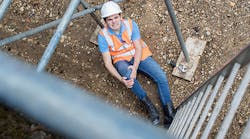Working at Heights: Why the Risks of Occupational Accidents Still Fall on Deaf Ears
Falls from heights remain the biggest cause of occupational fatalities in the construction industry. According to a report by the NIOSH Fatality Assessment and Control Evaluation program, 42% of deaths between 1982 and 2015 in construction involved falls; 54% of workers killed had no access to a personal fall arrest system; and 20% of fatalities occurred in the victims’ first two months on the job.
Newest data by OSHA suggests that falls from heights will remain the leading cause of workplace fatalities in 2017/2018. As of today, 566 out of 1623 occupational deaths in the U.S. were caused by falls, which equals roughly 35% of all death causes. Not surprisingly, fall protection was the most frequently cited violation by OSHA in 2017.
These findings paint a clear picture: The risk of falling from heights is not being managed and prioritized according to its devastating effects on workers’ well-being and safety. Why have we not found a solution to fall prevention that is able to decrease the number of annual accidents effectively?
The Danger of Falling
Injuries caused by falls are more likely to be life-threatening than most other types of injuries. While other common causes for accidents—such as falling objects, overexertion, or vehicle or machine accidents—are more likely to injure only a part of the body, injuries from falls can easily affect the whole body and vital organs.
The chances of surviving a fall from more than 30 feet are low, but even six feet can prove deadly when landing on the wrong body part or surface. Spinal, head, or neck injuries are a common result of falls, regardless of the height, and can leave the worker severely disabled or lead to death.
Although it seems to be the leading cause of death in the workplace, falls are actually not the most common cause of injury. Instead, overexertion and bodily reaction led to days away from work more often in 2012-2016. Similarly, nonfatal injuries from contact with objects or equipment showed a similar incidence rate to falls, slips, or trips.
In other words, falls from height are not the most common type of accident, but when they happen, they are much more likely to be deadly than other occupational accidents. More so than the quantity of fall-related incidents, it is the severity that we need to focus on to decrease the number of fatalities.
Using Safety Protection Correctly
Effective fall protection depends on an informed choice of equipment and knowledge on how to safeguard oneself and others from potential hazards. Workplace safety is, therefore, a two-step process, which involves, first, technical support from tools and machinery that can shield and protect in dangerous situations, and second, human support in the shape of comprehensive training, instructions and guidance.
Neglecting either of the two will most likely cause the safety system to have “holes” that will lead to breaches and dangerous working conditions for everyone at the site. Only professional, competent health and safety consultants can advise on how to guarantee protection and compliance according to site- and case-specific conditions.
Safety equipment has become vastly effective and affordable in recent years, making it easy to choose the right solution to each individual task. Instead of going with one-size-fits-all solutions, well-tailored and modifiable equipment can potentially make every site completely hazard-free. A combination of fall arrest systems, edge protection, scaffolds and safety equipment (like lighting, ladders, protective gear, etc.) should be able to prevent injuries—if used correctly.
Even the newest and most expensive equipment won’t keep a worker safe from accidents if the worker does not know how to use it. While there are many guides on what equipment to use for what situation, these guides are highly hypothetical and cannot teach hands-on instructions that workers can apply immediately.
Therefore, safety training should be a top priority for any company, regardless of the size or the industry. Safety training, done by a professional safety consultant at regular intervals, will educate staff on how to use tools, how to spot a potential hazard, and how to maintain a health and safety culture in the workplace that will spark awareness and interest in safety procedures among workers.
The Future of Fall Protection
A good safety plan not only saves workers’ lives, it also profits a company’s revenue immensely. According to the National Safety Council, every $1 invested in injury prevention can return between $2 to $6 as productivity increases, contentment with work and the workplace among employees rises, and higher retention creates a more sustainable and successful working environment.
OSHA is running fall prevention campaigns as part of an initiative to decrease the number of victims from falls from height. But in the end, the responsibility for creating urgency when it comes to safety culture lies with the employer. Fall protection stands or falls with every individual on site and cannot be considered solely as a structural or corporate issue.
Instead, the future of fall protection will be decided in close cooperation with those directly affected by it—the employees. Companies that take safety as a task that can be handled on the executive level are taking the wrong approach. An understanding of safety culture will only reach the worker if they are involved in the discussion, and only then can all work together to reduce fatalities.
Katharina Busch is a content writer at Arinite, a health and safety consultancy. She regularly writes about workplace safety, health and safety compliance, and safety business strategy.
